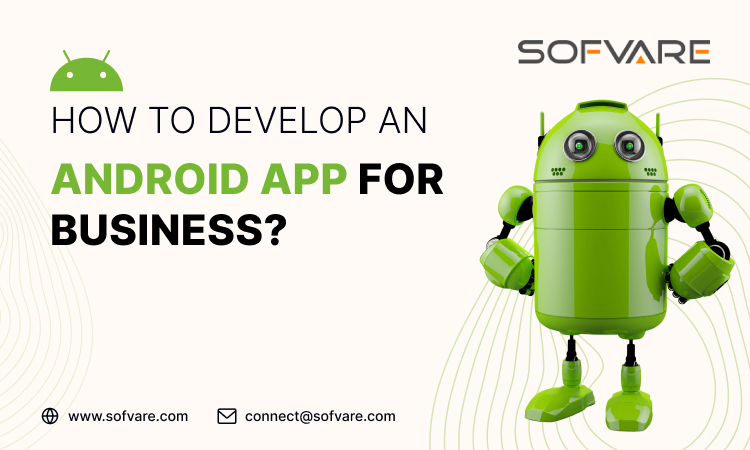How to Develop an Android App for Business?
In the digital age, mobile apps have become an irreplaceable entity for any business, regardless of its size. Mobile apps let you directly connect with customers. They boosts brand visibility and offers a smooth user experience. With around 3.9 billion active Android users globally, developing an Android app expands your reach and engagement potential.
This guide will be your companion as you go through the main steps involved in the process, empowering you to conquer the development of Android apps successfully.
1. Describe Your App Concept and the Target Audience
To make a successful app, you need a great idea. It must fix a problem for certain people. Ask:
- What difficulty does the app remove?
- What unfilled need does it satisfy?
- Who will use it?
- What value does your app give them?
- Why should they stop using other options and switch to yours?
2. Create an Appealing, User-Friendly Interface1
First impressions matter. The UI and UX design of your app will be the top factors that will determine whether users will stay engaged and satisfied or not. Here are some principles to keep in mind:
- Simplicity and intuitiveness: Follow a clean, uncluttered design principle. The interface must be user-oriented, and the user should get what they are looking for quickly.
- Consistency: Keep the look and feel of the website consistent to ensure users will not get confused when moving from one page to another.
- Responsiveness: Remember that the app should have a good look and should be working perfectly on many screen sizes and different types of Android devices.
3. Choose the Appropriate Development Model
The newcomers usually have new concepts and approaches, whereas the indigenous people have many years of history and connections to their original territories.
There are two primary approaches to consider for Android app development:
- Native Development: The development of this application will be done with Android Studio IDE and JAVA or Kotlin as programming languages.
- Cross-Platform Development: This approach lets you write a single code base that can be deployed on Android and iOS platforms. Hence, it will save your time and money.
The Evolution of Mobile App Development
4. App Development Functionality and Features
Now you have the mission and target audience defined, you can go on to the features and functionalities that will be delivered within the app. Here are some important considerations:
- Core functionalities: Discuss the unique features of your app that make it different from the rest of the apps in the market. This is your main value proposition.
- Advanced features: The app could have a feature that would make it easier to use and thus make it more attractive than the other apps.
- Scalability: Consider how the future can be implemented into your design and what new features you are planning to add by an extensible architecture.
5. Development and Testing Processes
Building an app involves coding, constructing, assessing, and publishing. A simplified outline follows:
- Development: You’ll select programmers to create the app based on the features you want. They’ll handle coding per your agreed functions.
- Testing: First, the app undergoes rigorous testing. Ensuring it’s error-free and user-friendly across devices and Android versions.
- Deployment: Once thoroughly tested, the app goes to Google Play for review and publishing.
6. The App Launch and The Way Ahead
The setup is done, and your application faces the Play Store now. This is merely step one, though. Several vital actions await:
- When seeking notice, optimize is key – with the right keywords employed, enticing descriptions crafted, and visuals that grip. Custom listing finesse ensures customer flow.
- Promoting and drawing users requires strategizing strong. Tailor marketing to core audience’s needs.
- Analytics and user input are imperative. Check dashboards for monitoring, and performance. Remember the users! Within the app itself, gather reviews, surveys, feedback.
- Updates and Maintenance: Try to implement new features and at least fix any bugs quickly. Security patches, make sure to keep up.
Mobile App Development Firm: Critical Partners
Creating a successful Android app, and takes more than an idea. The technical know-how and the experience, leading the development process, are the most crucial. Working with a skilled Android app development company provides valuable advantages:
- Team of Specialists: Development companies hire trained professionals – programmers, designers, project leads. They also make sure that decent practices are followed in all the stages, from the beginning to the end.
- Technical Leadership: They provide expertise in budgeting, functionality, interface, and platform peculiarities. Their guidance reduces risks.
- Project Management: A skilled development firm maintains punctuality, irrespective of financial overruns, by leveraging expertise in orchestrating endeavors.
- Ongoing Support: Post-deployment, they furnish technical assistance, addressing maintenance, updates, and emerging issues over time.
Selecting the right Android app development partner is crucial. Thorough research into portfolios, experience, and methodologies is vital before engagement, as this decision shapes your project’s realization.
Conclusion
Building an Android app for your business is essential while moving to a whole new level of customer orientation and brand awareness. This process is going to be followed by adhering to the planning idea, design, and development steps. If you are interested, you can also partner with an Android app development company to make sure that your idea becomes a successful and sustainable mobile application. However, remember that the app market is a dynamic and ever-changing environment, and you have to be aware of the trends, and user preferences, and make sure that you continuously modify and enhance your app to the current situation, to stay ahead of the curve and provide a great experience to your customers.

